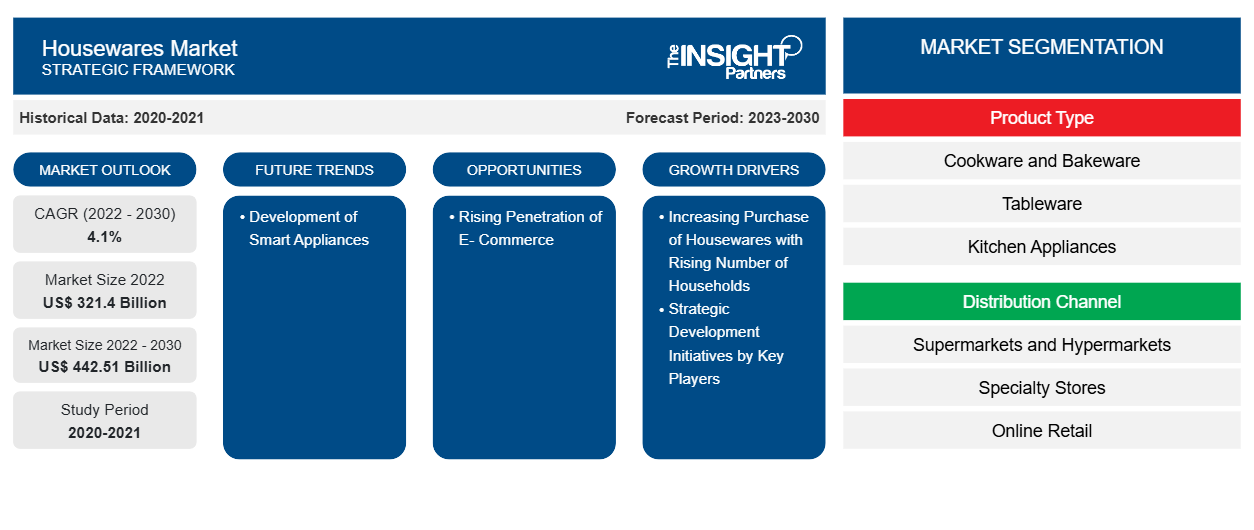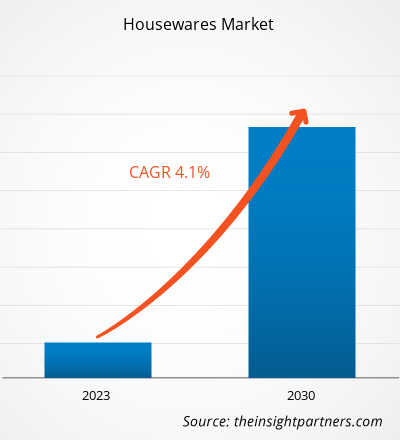[Research Report] The housewares market size was valued at US$ 321.40 billion in 2022 and is expected to reach US$ 442.51 billion by 2030; it is estimated to register a CAGR of 4.1% from 2022 to 2030.
Market Insights and Analyst View:
Housewares are products and items used within a household for cooking, baking, and home organization, among other purposes. The housewares market has been growing steadily due to factors such as changing lifestyles and more time spent at home, which have triggered the demand for functional and aesthetically pleasing housewares. During the COVID-19 pandemic, people spent more time at home and invested in improving their living spaces. Additionally, a rise of e-commerce and online shopping platforms has made it easier for consumers to access and buy a wide range of houseware products from their homes. These factors, coupled with innovative designs and sustainable options made available by houseware companies favor the expansion of the housewares market.
Growth Drivers and Challenges:
Dynamic changes in lifestyle and the rising dual-income families led to an upsurge in disposable incomes and improved living standards of households. With increasing disposable incomes, consumers spend significant amounts on housewares and other appliances supporting convenient living. They are often willing to purchase new products owing to their unique styles, which appeal to their individuality, resulting in a higher buying frequency. Moreover, a burgeoning number of single-person households triggers the need for home modifications, thereby driving the demand for housewares such as kitchen appliances, cookware, bakeware, tableware, and bathroom essentials.
Further, a rise in urbanization has been bolstering the demand for residential units and, ultimately, homewares products. As per the US Census Bureau and the US Department of Housing and Urban Development, the US completed construction of ~1,3 million housing units in 2021, whereas construction of ~1,7 million housing units was in progress. Similarly, rising urbanization in European countries has created a huge demand for residential housing. According to the European Commission, residential building permits increased by 42.3% from 2015 to 2021 in the European Union. In 2021, France, Germany, and Poland accounted for the most commencements of residential construction in Europe. Thus, the increasing construction of housing units across various countries further boosts the demand for housewares. Thus, the increasing purchase of housewares along with the rising number of households propels the housewares market growth.
However, the housewares market is highly fragmented and disorganized due to many untapped small private enterprises and street vendors operating in developing countries. According to an article published in Business Standards, as of 2020, 80% of the kitchenware market was unorganized in India. Local small businesses use low-quality raw materials to manufacture housewares such as cookware, bakeware, bathroom accessories, and tableware. The usage of low-quality raw materials results in poor-quality end products that are prone to damage. Also, manufacturers offer these products at low costs; therefore, the majority of consumers buy these products due to affordability and easy availability. This factor results in the shrinkage of the customer base of major houseware manufacturers.
Further, more often, local manufacturers in the unorganized housewares market do not comply with the regulatory standards, which can raise quality issues and hamper the perception of consumers toward houseware products. Further, the availability of counterfeit products can hamper the brand image of key players. Thus, the lack of uniformity in operations and regulations hampers the growth of the housewares market.
Customize This Report To Suit Your Requirement
You will get customization on any report - free of charge - including parts of this report, or country-level analysis, Excel Data pack, as well as avail great offers and discounts for start-ups & universities
Housewares Market: Strategic Insights

-
Get Top Key Market Trends of this report.This FREE sample will include data analysis, ranging from market trends to estimates and forecasts.
Report Segmentation and Scope:
The global housewares market is segmented on the basis of product type, distribution channel, and geography. Based on product type, the market is categorized into cookware and bakeware, tableware, kitchen appliances, bathroom essentials, and others. By distribution channel, the market is categorized into supermarkets and hypermarkets, specialty stores, online retail, and others. By geography, the global housewares market is broadly segmented into North America, Europe, Asia Pacific, the Middle East & Africa, and South & Central America.
Segmental Analysis:
Based on product type, the housewares market is categorized into cookware and bakeware, tableware, kitchen appliances, bathroom essentials, and others. The tableware segment is expected to register the highest CAGR during 2022–2030. The tableware segment includes products such as crockery, cutlery, glassware, and serveware. A surge in demand for tableware in the housewares market can be attributed to transformed dining habits during the COVID-19 pandemic. With more people dining at home, people have started focusing on aesthetic and functional tableware, as it enhances home dining experiences. From everyday meals to special gatherings, consumers are looking for tableware sets that elevate their dining experience. Furthermore, the growing appreciation for unique and artisanal designs plays a significant role in driving the demand for tableware. Consumers are increasingly drawn to handcrafted and artistically inspired tableware pieces that bring a touch of individuality and personality to their dining settings. Thus, a shift toward more personalized and visually striking tableware choices has contributed to the progress of the housewares market for the tableware segment. Vivo - Villeroy & Boch Group, Corelle, Pyrex, Luminarc, and Schott Zwiesel are a few of the prominent players operating in the market for tableware.
Regional Analysis:
The housewares market is segmented into five key regions: North America, Europe, Asia Pacific, South & Central America, and the Middle East & Africa. Asia Pacific dominated the global housewares market in 2022 as the market in this region was valued at US$ 120.63 billion in that year. Europe is a second major contributor, holding more than 23% share of the global market. Asia Pacific is expected to register a considerable CAGR of over 5% during 2022–2030. The growing urbanization and disposable income of the middle-class population is a prime factor propelling the demand for modern and convenient housewares, including advanced kitchen appliances and stylish tableware.
Housewares Market Regional InsightsThe regional trends and factors influencing the Housewares Market throughout the forecast period have been thoroughly explained by the analysts at The Insight Partners. This section also discusses Housewares Market segments and geography across North America, Europe, Asia Pacific, Middle East and Africa, and South and Central America.
Housewares Market Report Scope
| Report Attribute | Details |
|---|---|
| Market size in 2022 | US$ 321.4 Billion |
| Market Size by 2030 | US$ 442.51 Billion |
| Global CAGR (2022 - 2030) | 4.1% |
| Historical Data | 2020-2021 |
| Forecast period | 2023-2030 |
| Segments Covered |
By Product Type
|
| Regions and Countries Covered |
North America
|
| Market leaders and key company profiles |
|
Housewares Market Players Density: Understanding Its Impact on Business Dynamics
The Housewares Market is growing rapidly, driven by increasing end-user demand due to factors such as evolving consumer preferences, technological advancements, and greater awareness of the product's benefits. As demand rises, businesses are expanding their offerings, innovating to meet consumer needs, and capitalizing on emerging trends, which further fuels market growth.

- Get the Housewares Market top key players overview
COVID-19 Pandemic Impact:
The COVID-19 pandemic initially hindered the global housewares market due to the shutdown of manufacturing units, shortage of labor, disruption of supply chains, and financial instability. The disruption of operations in various industries due to the economic slowdown caused by the COVID-19 outbreak restrained the housewares supply. Moreover, various stores were closed, which limited the sales of housewares. Nevertheless, businesses started gaining ground as previously imposed limitations were revoked across various countries in 2021. Moreover, the implementation of COVID-19 vaccination drives by governments of different countries eased the situation, leading to a rise in business activities worldwide. Several markets, including the housewares market, reported growth after the ease of lockdowns and movement restrictions.
Competitive Landscape and Key Companies:
Bradshaw Home Inc, Denby Pottery, HF Coors Co Inc, Inter Ikea Holding Bv, Hutzler Manufacturing Co Inc, TTK Prestige Ltd, Newell Brands Inc, BSH Hausgerate GmbH, Kohler Co, and Haier US Appliance Solutions Inc are among the prominent players operating in the global housewares market.
Frequently Asked Questions
Based on the distribution channel, which segment led the global housewares market in 2022?
Can you list some major players operating in the global housewares market?
What are the drivers for the growth of the global housewares market?
What are the trends observed in the global housewares market?
Energy-saving appliances, notifications enabled on connected devices, and Wi-Fi capabilities are the key functional upgrades in smart kitchen appliances. For example, smart microwaves can seamlessly download cooking instructions, read barcodes on food products, and offer AI voice assistants to enable a completely hands-free experience. Whirlpool, in January 2022, announced that some of its smart, Wi-Fi-connected microwave would be upgraded to incorporate an air fry mode via a software update to replicate the crispy reheating specifications. Thus, the incorporation of innovative technologies into housewares is likely to bring new trends in the housewares market in the coming years.
Which product type segment is the fastest growing in the housewares globally?
- Historical Analysis (2 Years), Base Year, Forecast (7 Years) with CAGR
- PEST and SWOT Analysis
- Market Size Value / Volume - Global, Regional, Country
- Industry and Competitive Landscape
- Excel Dataset
Recent Reports
Testimonials
Reason to Buy
- Informed Decision-Making
- Understanding Market Dynamics
- Competitive Analysis
- Identifying Emerging Markets
- Customer Insights
- Market Forecasts
- Risk Mitigation
- Boosting Operational Efficiency
- Strategic Planning
- Investment Justification
- Tracking Industry Innovations
- Aligning with Regulatory Trends





















 Get Free Sample For
Get Free Sample For